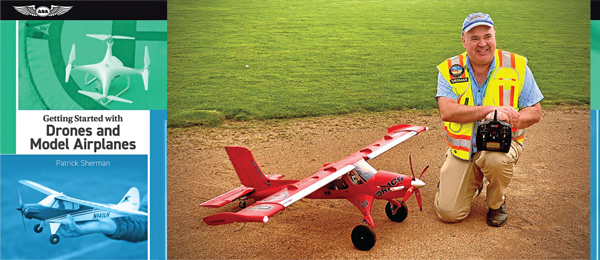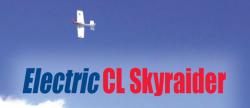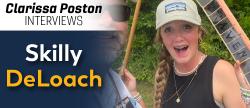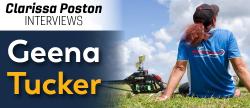New Book for Beginner Remote Pilots

New Book for Beginner Remote Pilots
Advanced Flight Technologies
By | [email protected]
As seen in the May 2024 issue of Model Aviation.
AFTER A DECADE as your "Advanced Flight Technologies" columnist, I’m excited to announce that I’ve written a book! There is one important detail to know right up front: I didn’t write it for you, and I want to apologize for that. However, I’m hoping that maybe you know a person who urgently needs a copy—or maybe even a whole bunch of people. A guy can hope, right?
My book is titled Getting Started with Drones and Model Airplanes, and it is being published by Aviation Supplies & Academics (ASA) of Newcastle, Washington. If you’ve spent any time at all around crewed aviation, you’ve heard of ASA. The company is the grande dame of aviation publishing, having gotten its start in 1940.

ASA, the aviation publisher based in Newcastle WA, has announced the release of the author’s new book, Getting Started with Drones and Model Airplanes.
I read ASA publications decades ago in college when I was earning my private pilot’s certificate. To think that ASA would return my phone call, let alone publish my book, is an idea that has taken me a while to fully accept. However, that’s where we are. So, what did I have to say that was so important that the company decided the world needed to read about it? I’m glad you asked …
After looking through ASA’s whole catalog and numerous other books on the subject of remote piloting, I realized that nobody had ever gone back to the first principles—the most basic ideas that every pilot needs to understand to be able to fly safely. Virtually every book addressed to this audience assumed that an underlying grasp of the fundamentals of aeronautics was had by all readers.
Of course, somebody who just goes out and buys a drone at Best Buy has no such grasp, so my goal was to fill that gap. While I was at it, I also decided that this would be a great opportunity to introduce a new generation to the joys of model aviation. Alongside drones with 4K video cameras and high-tech sensors, I talk about how model airplanes work and how people can get involved in the hobby.
This is the first book from ASA to extensively cover model aviation, so I’m hoping it will bring this exciting and educational pursuit to a whole new audience.
First Things First
In writing this book, my premise was that becoming a recreational remote pilot is analogous to becoming a private pilot. Neither is allowed to fly for compensation, but both provide the opportunity to develop the skills and understanding required to advance a career in piloting. In crewed aviation, the regulations give a novice pilot no other choice.
I argue that commercial remote pilots should follow this same general course: start out flying for fun so that you are able to take advantage of AMA’s unbeatable insurance and safety program, and then log your initial flight hours in low-risk operations that will serve to develop your hands-on skills. Along the way, you’ll come to understand the regulations and why they are important so that you will be better prepared when you do don the mantle of Part 107.
Furthermore, I think it’s important that anybody who is going to call themselves a pilot—of anything—should understand the four forces of flight, why aerodynamic stalls occur, what control surfaces are, and the meanings of pitch, roll, and yaw. As I mentioned at the outset, this book is not for you, a seasoned aeromodeler. Rather, it is for someone who is truly just getting a start and knows none of this.
From my point of view, the problem is that drones, in particular, have become so easy to operate that it is possible to fly one without any background in aeronautics at all. Flip through the manual for the latest and greatest out of Shenzhen and you won’t see anything about thrust, lift, drag, or weight. However, aviation is—and always has been—a community, wherein each of us is at least as dependent on the skills and the judgment of the aviator next door as we are on our own.
If this is to continue to be true, as it must, then we all need to be working from the same foundation of knowledge. My goal was to impart that knowledge in the most clear, direct, friendly, and entertaining way possible. I am completely serious when I write that I would sincerely appreciate hearing from you, as an experienced remote pilot, on whether or not I was successful.
Cover to Cover
The book is divided into 10 chapters. The first eight cover, in my judgment, everything that a new remote pilot needs to know, laid out in the order that will allow for the easiest comprehension. The following is a brief outline:
The first chapter focuses on safety as the first and overriding priority of all aviation activities, including flying drones and model airplanes. Chapter two describes the rules and regulations that govern recreational remote piloting, with a particular emphasis on how they relate to the safety of flight. In the third chapter, I develop a taxonomy of flying machines, describing the performance and characteristics of airplanes, rotorcraft, and vertical takeoff and landing aircraft, along with more peculiar specimens.
Chapter four is dedicated to the science of aerodynamics—basically, everything I learned about flight during the first two days of ground school while earning my private pilot’s certificate. The fifth chapter describes the components of remote-controlled flying machines and how they all work.

For the past 100 years, every new pilot has begun their understanding of aerodynamics with this simple concept. With his new book Getting Started with Drones and Model Airplanes, the author hopes that new drone pilots who are taking flight every day will embrace that tradition.
In chapter six, I outline options for learning how to fly, including the use of simulators and making new friends. The seventh chapter explores how to evaluate new flying sites, and chapter eight addresses the thumbs-on-sticks essentials of how to guide a machine through the air.
The final two chapters look at all of the fun you can have as a remote pilot. Chapter nine covers the fundamentals of aerial photography, and the last chapter looks at the diverse range of activities open to recreational pilots through AMA, from FPV racing to Aerobatics and Pattern flying, and Soaring to Control Line and Free Flight.
You and Me
It was a genuine privilege for me to be able to write this book. I hope you find it worthwhile and of value when you are trying to introduce someone to model aviation or persuade your friend who just got a new drone that there are indeed rules, and that they exist for a good reason. Beyond that, I feel compelled to offer my thanks to those of you who have been reading my columns for the past 10 years.

Although he began his career in remote piloting focused on small UAS, otherwise known as drones, the author has gained much appreciation for—and experience with—model aviation throughout the past 15 years. This has been a critical influence in writing his first book, Getting Started with Drones and Model Airplanes. Photo by Michael Rigby.
I believe it was that sustained level of support that gave me the insight, the confidence, and the credibility to take on a project such as this and, I hope, ultimately make it successful. This gratitude extends to AMA itself, to Jay Smith, Jennifer Alderman, and everyone at Model Aviation magazine who has embraced my work for all of these years, as well as the organization’s entire leadership team, including Executive Director Chad Budreau and, most especially, to AMA President Rich Hanson, who wrote the foreword to my book.
This all comes across as sounding a bit like a valedictory address, I realize. However, that was not my intention. You can rest assured that I’m not going anywhere—not unless they throw me out, anyway. I’ll be back in the July issue, discussing some obscure remote piloting technology, emerging safety issue, or the ever-expanding universe of possibilities that are available for these marvelous flying machines and the people who pilot them.
Until then, fly safely!
SOURCES:










Add new comment